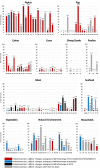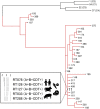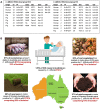Genomic Delineation of Zoonotic Origins of Clostridium difficile
- PMID: 31281807
- PMCID: PMC6595230
- DOI: 10.3389/fpubh.2019.00164
Genomic Delineation of Zoonotic Origins of Clostridium difficile
Abstract
Clostridium difficile is toxin-producing antimicrobial resistant (AMR) enteropathogen historically associated with diarrhea and pseudomembranous colitis in hospitalized patients. In recent years, there have been dramatic increases in the incidence and severity of C. difficile infection (CDI), and associated morbidity and mortality, in both healthcare and community settings. C. difficile is an ancient and diverse species that displays a sympatric lifestyle, establishing itself in a range of ecological niches external to the healthcare system. These sources/reservoirs include food, water, soil, and over a dozen animal species, in particular, livestock such as pigs and cattle. In a manner analogous to human infection, excessive antimicrobial exposure, particularly to cephalosporins, is driving the expansion of C. difficile in livestock populations worldwide. Subsequent spore contamination of meat, vegetables grown in soil containing animal feces, agricultural by-products such as compost and manure, and the environment in general (households, lawns, and public spaces) is contributing to a persistent community source/reservoir of C. difficile and the insidious rise of CDI in the community. The whole-genome sequencing era continues to redefine our view of this complex pathogen. The application of high-resolution microbial genomics in a One Health framework (encompassing clinical, veterinary, and environment derived datasets) is the optimal paradigm for advancing our understanding of CDI in humans and animals. This approach has begun to yield critical insights into the genetic diversity, evolution, AMR, and zoonotic potential of C. difficile. In Europe, North America, and Australia, microevolutionary analysis of the C. difficile core genome shows strains common to humans and animals (livestock or companion animals) do not form distinct populations but share a recent evolutionary history. Moreover, for C. difficile sequence type 11 and PCR ribotypes 078 and 014, major lineages of One Health importance, this approach has substantiated inter-species clonal transmission between animals and humans. These findings indicate either a zoonosis or anthroponosis. Moreover, they challenge the existing paradigm and the long-held misconception that CDI is primarily a healthcare-associated infection. In this article, evolutionary, and zoonotic aspects of CDI are discussed, including the anthropomorphic factors that contribute to the spread of C. difficile from the farm to the community.
Keywords: Clostridium difficile; evolution; livestock; one health; transmission; zoonosis.
Figures



Similar articles
-
Evolutionary and Genomic Insights into Clostridioides difficile Sequence Type 11: a Diverse Zoonotic and Antimicrobial-Resistant Lineage of Global One Health Importance.mBio. 2019 Apr 16;10(2):e00446-19. doi: 10.1128/mBio.00446-19. mBio. 2019. PMID: 30992351 Free PMC article.
-
Isolation of Toxigenic Clostridium difficile from Animal Manure and Composts Being Used as Biological Soil Amendments.Appl Environ Microbiol. 2018 Aug 1;84(16):e00738-18. doi: 10.1128/AEM.00738-18. Print 2018 Aug 15. Appl Environ Microbiol. 2018. PMID: 29858208 Free PMC article.
-
Clostridium difficile colitis and zoonotic origins-a narrative review.Gastroenterol Rep (Oxf). 2018 Aug;6(3):157-166. doi: 10.1093/gastro/goy016. Epub 2018 Jun 28. Gastroenterol Rep (Oxf). 2018. PMID: 30151199 Free PMC article. Review.
-
Clostridium difficile in soil conditioners, mulches and garden mixes with evidence of a clonal relationship with historical food and clinical isolates.Environ Microbiol Rep. 2020 Dec;12(6):672-680. doi: 10.1111/1758-2229.12889. Epub 2020 Oct 7. Environ Microbiol Rep. 2020. PMID: 32975368
-
Clostridium difficile infection in the community: a zoonotic disease?Clin Microbiol Infect. 2012 Jul;18(7):635-45. doi: 10.1111/j.1469-0691.2012.03853.x. Epub 2012 Apr 27. Clin Microbiol Infect. 2012. PMID: 22536816 Review.
Cited by
-
Clostridioides difficile in Calves in Central Italy: Prevalence, Molecular Typing, Antimicrobial Susceptibility and Association with Antibiotic Administration.Animals (Basel). 2021 Feb 16;11(2):515. doi: 10.3390/ani11020515. Animals (Basel). 2021. PMID: 33669325 Free PMC article.
-
Horses as a Crucial Part of One Health.Vet Sci. 2020 Feb 29;7(1):28. doi: 10.3390/vetsci7010028. Vet Sci. 2020. PMID: 32121327 Free PMC article. Review.
-
Defining the phylogenetics and resistome of the major Clostridioides difficile ribotypes circulating in Australia.Microb Genom. 2024 May;10(5):001232. doi: 10.1099/mgen.0.001232. Microb Genom. 2024. PMID: 38717815 Free PMC article.
-
Phenylthiazoles with potent & optimum selectivity toward Clostridium difficile.RSC Med Chem. 2024 Mar 22;15(6):1991-2001. doi: 10.1039/d4md00164h. eCollection 2024 Jun 19. RSC Med Chem. 2024. PMID: 38911156 Free PMC article.
-
The Colonisation of Calves in Czech Large-Scale Dairy Farms by Clonally-Related Clostridioides difficile of the Sequence Type 11 Represented by Ribotypes 033 and 126.Microorganisms. 2020 Jun 15;8(6):901. doi: 10.3390/microorganisms8060901. Microorganisms. 2020. PMID: 32549307 Free PMC article.
References
Publication types
LinkOut - more resources
Full Text Sources

